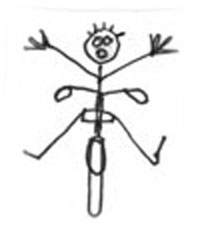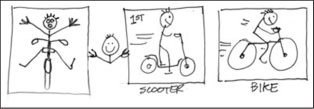Painless Biking News

Bike Riding News: Kids Know Less Painful Way To Learn
In Content Areas I told a story about learning to ride a bike — the painless method. Here it is. First I’ll retell the story in the book, then bike enthusiast and teacher Jon Moss refines the painless process below:
My son tried to learn to ride a bike the painful way because that’s the way we taught him. When Andy started riding, he wanted training wheels. My wife and I knew he was postponing the real work, that there was no painless way to learn to balance, but he was so happy riding and at least he was learning to peddle and steer. Eventually Andy decided he was too big for babyish training wheels.
We gulped and agreed, but we told him our lumpy narrow sidewalks weren’t the place to learn to balance. We took him to what we considered the perfect spot. At the top of the little slope of pavement, my wife held Andy’s seat and got him going. He rolled ahead and then he began weaving side to side before he threw both hands and legs out. His crash into the handle bars was dramatic and painful.After that crash Andy didn’t want to ride anymore. Then one day he picked up a junky scooter at a garage sale. While all his friends rode bikes, he shoved that old scooter around.

Then one day, Andy announced he was ready to ride his bike. We agreed to help, but we warned him he needed to be ready for a few spills. He said, “I don’t need any help. I know how to ride now.” We asked if he’d practiced on a friend’s bike. He said, “No,” but insisted, “I know how to ride now.” Reason wasn’t getting us anywhere, so just to humor him, we dug his bike out of the basement. He wouldn’t even let us give him a helpful push. He got on, shoved off, and wobbling a little he peddled away down the lumpy sidewalk. As he sailed by us on his first trip around the block we were beginning to grasp the concept he was teaching.
He had learned to balance standing on that crummy old scooter, no-fault balancing where he could just step off whenever he lost it. This was balancing with no crash, no blood, no pain. He just rode and learned to balance. No problem. Andy’s painless riding news is as follows: To learn to ride a bike, first get a scooter.
Painless Bike Riding Best Practice Update

Jon says, “As Roger points out in the book, I was present for a discussion on teaching people to ride bikes. I explained to Roger that generally, the real issues with bike riding are confidence and balance, not strength. Training wheels just improve strength but delay achieving balance. Mom or dad doing the balancing for the rider and slowly withdrawing the help, really addresses confidence. The “no pedal method” addresses balance and confidence directly and rapidly. Here is the system:
- Get a bike that the rider can sit on and still reach the ground with his/her feet.
- Remove the pedals from the bike. (Remember that one pedal is “lefty loosey” the other is not).
- Have the rider sit on the seat and use the bike as a scooter.
- Let the rider scoot up and down the driveway, sidewalk, parking lot, and/or road. No helping!
- In a short period of time, the rider will be coasting and not touching the ground!!!
- Let the rider practice the scooting and coasting a few minutes more.

- Put the pedals back on and voila!!!!
